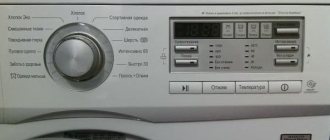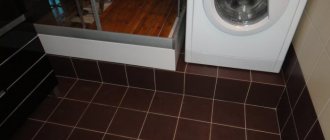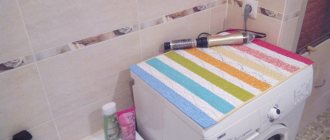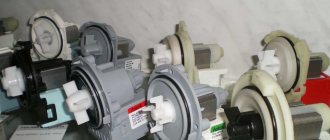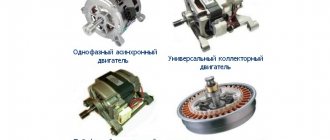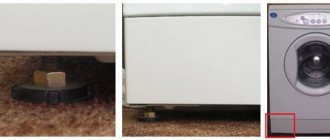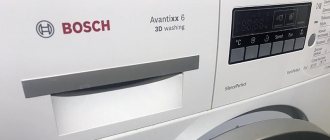From scale From mold At home From dirt Automatic Clean the compartments Clean the pump Simple methods Tips for the home From plaque From dirt Tips suitable for washing machines: Zanussi LG Indesit Ariston Atlant Electrolux Hansa LG Candy (Kandy) Samsung Bosch (Bosch), etc.
Cleaning the washing machine. We extend the service life of the automatic machine. We analyze all the methods of cleaning from dirt, scale, fungus, etc.
We are so accustomed to convenience that now not a single housewife can imagine her life without an automatic washing machine. And only the most low-income families do not have it, where they still wash in a basin, but still plan to buy it.
What could be the reasons for contamination in the washing machine and what can you expect:
- Moisture may cause mold to appear on the rubber seal;
- During operation, scale appears on the heating element;
- Residues of washing powder stick;
- The drain pump filter is dirty;
- Rust or stones appear in the inlet hose filter.
All this leads to an unpleasant odor and rapid breakdown of the washing machine. And in order to avoid damage from dirt, you should periodically clean the car either with special products or with handy ones that you find at home.
How to clean a washing machine filter
If you do not clean the filters in time, then soon after they become dirty and clogged, you can cause a severe flood.
What do you need to clean the filter? Prepare a rag, a flat container and a screwdriver. Find the panel at the bottom (most often it is the socket on the bottom left), open it and unscrew the filter. Before doing this, do not forget to place a flat container and keep a rag ready, since a small amount of water will still spill out from there.
Once you open the filter, remove all dirt and accumulated debris. By the way, sometimes you can find interesting things there). Next, wipe the hole, screw on the filter and close the lid tightly.
Part removal technique
Once you have been able to find the part you need, you should carefully remove it so that you can then proceed to the most important thing - cleaning the washing machine filter.
It is important that you take it out as carefully as possible, as you may accidentally damage other fragile parts of the machine.
Always remember that in designs from the indesit company the surge protector is made of the thinnest plastic. That is why, during removal, you need to carefully pry up the filter on both sides with a screwdriver that we already know and remove it only at the moment when it begins to come away on its own, but not in any way pull it towards you.
In general, removing a filter from an automatic washing machine is not so difficult when it comes to regular filters: you just need to turn its cap counterclockwise.
Don't forget to prepare a dry, moisture-absorbing rag in advance. This is necessary so that you can quickly wipe away excess water, which will certainly leak out when removing the filter. You need to place a cloth under the panel itself, which covers the filter pump, and only then start removing the part.
To do this, turn it a couple of circles counterclockwise and remove it towards you.
After this, you can begin the cleaning itself using one of several of the most well-known methods. As a rule, cleaning a washing machine filter does not take much time if you do everything correctly and promptly.
How to clean a washing machine from smells
Sometimes your washing machine may smell musty. This is due to the fact that you could take cheap, poorly dissolving and leaching detergents. They accumulate on the walls and cause an unpleasant odor later.
If you do not dry your car, mold or mildew may appear, which also gives off an unpleasant odor and stains your clothes.
- Always rinse the tray after every third wash.
- If the channel from where the detergent enters the machine is clogged, clean it with a small brush containing chlorine.
- Clean the drain filter
- Clean your washing machine from limescale
Such manipulations will help you get rid of odors and extend the life of even an old washing machine.
Rules of care
To prevent contamination of the washing machine, and in particular the detergent drawer, you must:
- Install a water softener in front of the machine;
- Wash the car after each wash;
- After use, leave the door open to allow moisture to evaporate;
- Systematically clean the powder tray;
- Use only high-quality and expensive powders from well-known manufacturers;
- Rinse the car additionally after using bleaches.
How to descale a washing machine
We clean the heating element itself and the washing drum from scale, since this is where the heating elements are located. Over time, mineral deposits of salts and lime adhere to these elements. Essentially, these are Magnesium and Calcium salts. Therefore, the best thing is to remove it with acids. At home it is vinegar and citric acid.
Recipes:
- Clean with vinegar: 2 cups 9% table vinegar, 1/4 cup baking soda. Pour the mixture of water and soda into the powder container, and vinegar into the drum itself. We turn it on for maximum operating time at the highest temperature. If there is a boiling function, use it.
- Citric acid: Citric acid 1-6 packs depending on the contamination. If you haven’t cleaned it for a long time, then more is better. Pour the acid directly into the powder compartment. Turn on the longest wash and temperature mode, as in the first case.
- Soda. 500 grams of baking soda are poured into the drum, and 1 liter of 9% table vinegar is poured into the receiving tray. The program with the highest temperature is set. This option will help you clean not only the tank and heating element, but also the drain channels.
Powder receiver
The tray where washing detergents are loaded must also be washed systematically. After the cycle, a small part of the powder remains in the dispenser, sticking to the walls. So, over time, the particles of the substance harden, and in addition to plaque, mold and mildew may appear in the cuvette. Formations hazardous to human health are spread throughout the washing machine, remaining on clothes and laundry. Timely cleaning of the powder receptacle will help prevent the appearance of harmful substances, plaque, and an unpleasant, heavy odor from SMA.
It is recommended to rinse the powder cuvette after each wash.
When the container has no visible dirt, it is enough to simply rinse it with warm water and walk over the tray with a brush. If there is already hardened plaque on the walls, you need to soak the dispenser in a citric acid solution for several hours. Afterwards, clean thoroughly with a brush or abrasive sponge and rinse.
When the contamination is serious enough, you will have to resort to household chemicals. It is allowed to use the product for plumbing or tiles. Work must be done with gloves, as such compounds are too aggressive. If black moldy spots are visible on the cuvette, the surface should be treated with an anti-mold agent.
In very advanced cases, the powder receptacle may not be pulled out of the machine due to severe contamination. Then you can try pouring warm water into the tray and using a brush or small brush, try to clean the dispenser. If this attempt does not lead to anything, use citric acid. Place one bag into the container, the second into the drum, and start the wash. The system, and at the same time the cuvette, must be cleaned.
How to clean a washing machine drum
Why might the drum become dirty? There are several options for contamination:
- Sand and dust from dirty clothes
- Grains of sand and particles of rust from the water supply
During washing, these solid particles combine with limescale impurities from the water and gradually stick (settle) on the drum. It is especially difficult to clean the inner, invisible part of the drum from contamination.
When you start cleaning your car, follow these steps:
- Wipe the walls of the drum with a damp cloth, thereby wetting the surface and also removing large dirt;
- Pour baking soda onto a damp cloth and thoroughly clean the drum. Baking soda removes scale, grease and accumulated dirt;
- Leave the soda for half an hour and then wash off the remaining dissolved dirt with a clean cloth;
- Add diluted vinegar, bleach or citric acid to the powder tray. What is at hand;
- Set the maximum wash time at a temperature of 60ºC and without the rinse function;
- After finishing the program and draining the water, put the machine on a double rinse to completely remove any remaining solution in the tank.
This way you can protect your car from wear and tear in time and extend the service life of both the heating element and the tank.
Cleaning the tank and drum
For these purposes, you can use citric or acetic acid or a bleach solution. The selected substance is poured or poured into the SMA drum, after which a mode is started lasting more than an hour, which involves heating the water above 75°C. Washing is carried out “idle”, that is, without laundry.
At the end of the program, it is important to run the “Rinse” twice. This will remove any remaining detergent from the tank. Users who perform this procedure once a month do not have to worry about the accumulation of dirt and debris in the drum.
It is possible to clean the surface of the drum manually. The algorithm of actions will be as follows:
- take a damp cloth or sponge. Wipe the walls, thereby moistening them;
- pour the powder onto the sponge and begin treating the surface, using special effort to clean the places where dirt accumulates;
- leave the washer for an hour so that the detergent composition is absorbed and completely corrodes the dirt deposits;
- clean any remaining debris from the walls with a dry cloth;
- run the “Rinse” mode to remove any remaining powder from the system.
You can clean the machine using Frisch Activ. For this:
- pour “chemistry” into the SMA tray (1/2 cup included in the kit), the other half - directly into the drum;
- start the washing program with the drain turned off. Water heating temperature – minimum 75°C;
- at the end of the cycle, let the machine stand for 30 minutes;
- drain the system.
Some modern models of Indesit machines are equipped with a special drum self-cleaning mode. By running such a program, you can get rid of debris on the walls without any physical effort on the part of the user. If it is necessary to get rid of scale, it is recommended to turn on the self-cleaning mode together with the use of Frisch Activ.
How to clean an elastic band in the washing machine
The rubber in the machine serves as a seal and also gets clogged like other parts. Both dirt particles and water accumulate under it, which can cause fungus to develop or mucus to form. It’s not very pleasant if dirt from under the elastic gets onto clean linen.
To prevent the formation of deposits, do preventive maintenance after each wash:
- Use a cloth to dry any remaining water under the rubber band;
- Leave the car door open for a while. so that it dries completely;
- Try to ventilate the room itself from moisture where the washing machine is located.
If you already have a fungus, the following ingredients will help you clean it:
- Soda
- Dishwashing liquid
Mix baking soda and dish liquid approximately 1:1. Using a sponge, apply the resulting solution to the entire surface of the elastic inside, rub it and leave for half an hour. Then rinse it thoroughly and wipe with a dry cloth. If the contamination is very strong, then take any disinfectant that does not contain chlorine.
Chlorine-containing cleaners can corrode the rubber seal or deform it.
System health check
Upon completion of cleaning, you need to check the Indesit machine for functionality by turning it on in the accelerated wash mode with mandatory rinsing.
After waiting for the end of the cycle, you need to carefully monitor the process of draining the water and make sure there are no failures . If you find that the signs of clogging have not disappeared, you will have to disassemble the filter again and consult with specialists about its condition.
Problems after
Sometimes, when draining after cleaning, waste water begins to seep out from under the technical hatch door. This means that during assembly the filter housing is not installed tightly enough. You will have to remove it again and re-install it.
Sometimes the cause of smudges and signs of clogging is complete wear of the filter element. In this case, after receiving confirmation from professionals, you will need to dismantle it and replace it with a new product.
How to clean mold from a washing machine
Mold can appear not only under the rubber seal. If it is in a damp and cool room, then every part can become “infected” with fungus. Constantly wet parts are especially susceptible to infection: the elastic band, the tray and the drain.
If you do not get rid of it in time, then not only the machine, but also the person living in the apartment may suffer. The fungus produces a huge number of bacteria that cause allergies and pulmonary diseases.
How you wash your clothes also affects mold.
- Wash only on cold cycles up to 40°C. This temperature does not kill the fungus, but only creates favorable conditions for spores to reproduce and develop.
- Washing without the use of active bleaching agents. Gentle powders without chlorine and phosphates cannot kill the fungus. But the active substances will help get rid of it even if you decide to bleach your bed linen.
- Using air conditioning. When using it, it is necessary to include an additional rinse to wash away the remaining conditioner from the walls of the machine. The laundry will remain with the same properties that you would rinse once. If you use a one-time rinse, the remaining conditioner will remain on the walls. And this is a favorable environment for the development of mold.
Stages of cleaning the washing machine from mold:
- Wash the tray, rubber seal and other contaminated visible parts of the machine with laundry soap;
- Pour regular white into the dispenser and put it on a long wash;
- In the middle of the cycle, stop the machine for 30-60 minutes;
- Pour 2-3 cups of 9% vinegar into the measuring tank and set to rinse;
- After washing, wipe the machine dry.
This method helps in advanced cases when you need to clean not only externally, but also internally the entire washing machine.
Possible problems after
Cleaning the filter is a fairly simple procedure, but sometimes problems with water leakage at the work site may subsequently arise.
This state of affairs indicates that the installation was not carried out efficiently or there is a defect in the part. To restore the tightness, the unit will have to be disassembled and reassembled.
When re-disassembling the unit, it is necessary to very carefully inspect the work area, since physical wear of the parts is possible. If this assumption is confirmed, it is necessary to replace the filter element. In cases where the gasket is worn out, it is only possible to replace it.
In the event that you cannot independently determine the cause of the leak, it is recommended to call a specialist.
How to clean a washing machine tray
If you only need to clean the tray, use the following method:
- Remove the tray. This can be done in almost every car. You can simply pull out the tray all the way
- Spray with any universal cleaner;
- Rinse using the hard side of a sponge or a toothbrush;
- Rinse thoroughly and wipe dry.
The tray is the first step to contamination with mold, rust, etc. Try to care for it as often as possible, dry it after each wash, rinse it as soon as you see plaque appearing. And then your washing machine will serve you for a long and faithful service.
Possible difficulties
The drain filter is not always easy to unscrew from its seat. This problem occurs when the device is cleaned too rarely. The limescale layer accumulated at the junction of the part with the thread does not allow them to be separated. In such a situation, you have to remove the filter along with the pump. You can get the device by placing the washing machine on the floor with its side wall in such a way as to provide access to its bottom.
The bottom of the pump can be covered with a lid. It should be unscrewed, the pump separated from the pipes (by removing the clamps) and disconnecting the wires from the terminals. Unscrew the bolts used to secure the device to the drain system. Apply WD-40, which is good at removing rust and deposits, to the connection between the pump and the filter. Disconnect the parts. If this method does not help, carefully break off the filter element without damaging the pump threads. Now the old filter needs to be replaced with a new one.
Traditional methods of cleaning a car
How to clean a washing machine with citric acid
Citric acid is used for light stains, unpleasant odors in the car, and also as a preventive measure for heating element scale and for cleaning the drum. At the same time, if you compare it with expensive purchased products and read the composition, you will see that 75% of the product consists of acid. When compared, the benefits are obvious.
The procedure for cleaning the machine with citric acid:
- 50-100 grams of lemons are placed in a powder tray
- Select the longest washing mode and the highest temperature of 90 degrees
- After finishing the wash, set the machine again for an additional rinse.
If there is still a smell after cleaning, don’t despair. There is an explanation for this:
- You haven’t cleaned your washer for a very long time and after running it, all the plaque hasn’t been removed.
- With constant washing at 40 degrees, bacteria and fungus spread on the walls and it is already difficult to get rid of it
In such cases, repeat the cleaning procedure. After this, wipe the car dry and dry it with the hatch and tray open.
Remember! This is prevention. And it is advisable to use this method no more than once every 6 months.
How to Clean a Washing Machine Using Baking Soda
Soda helps get rid of mold, because when dissolved it creates an alkaline environment, which fungus does not like so much. Most often it is distributed on the sealing rubber, in the drum itself, in the powder tray.
Mode of application:
- Make a paste: half a glass of water and half a glass of soda, mix well to obtain a homogeneous mass.
- Apply a little paste to a sponge and wipe the affected area thoroughly. Try to use rubber gloves during the procedure
- Leave for a while and wipe with a damp cloth
- Turn the machine on to rinse mode
If you take citric acid and soda, you can partially get rid of scale, if the contamination is not severe6
- Take 150 g of citric acid and 2-4 teaspoons of baking soda
- Pour this mixture into the powder tray
- Turn the washing machine on the longest cycle at the highest temperature. When finished, repeat the rinse cycle again.
How to use vinegar when cleaning
Vinegar is used less frequently, but it can also be used for mildew or mildew.
- Pour 9% vinegar into the tray for liquid laundry detergent - 2 cups
- We start the machine at high temperature and select the longest washing mode
- After 10-15 minutes have passed, turn off the washing machine for a couple of hours in order to kill the fungus
- Next, continue washing and additionally set to rinse mode after stopping
- Wipe the entire interior surface and rubber seal with a soft cloth dampened with vinegar solution.
- Wipe the machine dry with a dry cloth and leave to dry with the hatch and tray open.
Interesting! Some housewives add 1-2 tablespoons during washing to soften the water and prevent scale. And if you add apple cider vinegar, you can get a pleasant smell for your laundry.
Cleaning the washing machine with bleach
Bleach, also known as Whiteness, helps fight mold and disinfect the most inaccessible places.
How to properly use bleach when cleaning:
- Pour 100 ml of white directly into the washing machine (drum)
- Turn on the mode with a temperature of 90 degrees for 30-40 minutes
- Then run an extra rinse
Use Whiteness no more than once every six months. When using Domestos, be careful - it tends to foam.
The best chemicals for cleaning automatic machines
If you still trust store-bought products more, then it is better to buy specialized drugs sold in specialized stores. The most purchased and popular ratings among users:
- Topperr 3004 (Germany) – suitable for descaling dishwashers and washing machines. Recommended by Bosh manufacturers.
- Schnell Entkalker (Germany) - quickly helps to get rid of lime deposits on internal elements.
- Antikalk for Washing Machines from Sano (Israel) is a universal gel for the prevention and elimination of small plaque with an antibacterial effect.
- Magic Power (Germany) is one of the best specialized products for washing machines. Available in the form of gel and powder, which effectively removes plaque from heating elements, tanks, and drums.
- Beckmann (Germany) is a universal product that will protect against scale and eliminate unpleasant odors caused by various contaminants. But, like any multi-purpose product, it is good for regular care, but will be ineffective against heavy dirt.
- Filtero 601 (Germany) – works well to remove old scale from the heater and other elements; it is recommended to use 3-4 times a year for intensive cleaning of the machine. Available in 200 g bags for one use.
- Doctor TEN (Russia) and Antiscale (Belarus) are inexpensive drugs that help remove scale from any heating elements.
- Bork K8P1 (Korea) – will clean scale. In stores it is sold in a package of 4 sachets.
- Shumanit Bagi (Israel) – gets rid of scale, limescale, and rust. Cleans surfaces well.
All these products are available in convenient packages in the form of powder or liquid products. I usually buy liquid products that contain bleach, which helps get rid of limescale and mildew.
These products also clean other appliances: irons, dishwashers, etc.
Why is cleaning necessary?
If you do not pay attention to the LG washing machine, then over time the following unpleasant manifestations will make themselves felt:
- the appearance of the household appliance itself will become unattractive;
- the quality of the wash will begin to deteriorate;
- the equipment will malfunction and may even fail very quickly;
- there will be mold in the machine;
- An unpleasant odor will appear from the drum.
The following factors can aggravate the situation:
- poor water quality;
- using unsuitable detergents;
- constant washing only with low water heating, which makes it difficult to properly break down and remove fats and other pollutants;
- violation of the rules for operating the washing machine.
Maintenance of washing household appliances must be regular and of high quality.
How to Clean a Top Loading Washing Machine
Top-loading machines also need to be cleaned periodically, as they accumulate even more bacteria, mucus and mold.
- We use the longest and highest temperature washing cycle
- Add 2-3 cups of 9% vinegar to the water, after a couple of minutes add half a cup of soda
- This starts the reaction. Leave the equipment in this form for 1.5-2 hours on pause
- While the machine is standing, wash the outside of it with a vinegar solution with a soft cloth.
- After the time has passed, turn on the machine and finish washing
- Wipe the inside with a cloth to remove any remaining dirt.
The best protection for household appliances is keeping not only the body clean, but also the cuffs and insides. As soon as the automatic parts become clogged, problems may appear: leaks, failure. Therefore, do not forget to take preventive measures that are easy to do yourself. Below is a small instruction that you need to know before launching our assistant to prevent frequent repairs.
Preventing blockages
The following preventive measures will help prevent blockages:
- Do not allow foreign objects to enter the drum. All pockets must be checked in advance, loose buttons must be sewn on, etc.
- Washing items stained with technical oils is not advisable, since substances partially washed off from the fabric are deposited on the components of the washing machine.
- Washing items with long, loose pile and a lot of pilling can lead to clogs.
- For washing in an automatic machine, you must choose only those detergents that are intended for this purpose. Using regular soap shavings, for example, can cause detergent to stick and cause a clog.
- From time to time, at least once a week, washing should be done at a high temperature of 60°C.
- Using water softeners will prevent the formation of strong limescale in hard tap water.
- It is advisable to clean with vinegar or citric acid once every 2-3 months.
- The drum should not be used as a place to store dirty items. Laundry baskets are suitable for these purposes.
- Already washed clothes should not be kept in the drum for a long time.
What happens if the filter is not cleaned?
Symptoms of a blockage can manifest in different ways. If there is a partial blockage, water will linger in the tank and drain more slowly than before. In this case, the unit can display a digital code on the display indicating an error. If the situation is neglected or in the event of a mechanical blockage, the washing cycle freezes, since debris blocks the pump and it stops pumping water.
The machine stops working. Undrained liquid is visible in the tank. Such signs may also appear during more serious breakdowns, for example, if the drain pump has failed. To rule out this option, you need to remove the filter and inspect it.
If the trap is partially leaking water, more and more dirt will accumulate inside. The deposits will serve as a favorable environment for microbes, and the dirt will begin to sour. There will be a repulsive smell coming from the machine. Washed clothes won't smell fresh either.
A foreign body that accidentally gets into the inside of the unit can slip into the drain during repeated washings and cause its breakdown. In this case, car owners will face expensive repairs or a complete replacement of the unit.
Option 3: Manually
Inspecting the electric heater is the first thing to do if you decide to clean the elements of the washing machine yourself. A thick layer of limestone is sometimes easier to remove by hand.
There is no need to use sharp objects for cleaning. There is a risk of damage to the coating of the heating element or its breakage. Place the element in citric acid diluted in water or in a solution with a special liquid.
Steps to manually clean an electric heater:
- First you need to disconnect the wires and sensor and remove the heating element.
- Then rinse the device with hot water to remove dirt and deposits.
- Place the element in a specially diluted solution to remove the remaining stone. You can take a plastic bottle with the neck cut off. Pour four tablespoons of lemon into it, place a heater in the bottle, and fill it with hot water.
- Shake the solution. How to understand that the process of dissolving salts has begun? Air bubbles will rise.
Let the heating element sit in the solution overnight. Then rinse it under water with a sponge and place it in the washing machine.
The electric heater is always located under the tank. However, depending on the brand of equipment, removing the element requires removing either the front panel or the back panel.
Household chemicals
On store shelves you can see a lot of products designed to clean and subsequently protect automatic machines from scale and other contaminants. The following solutions may be useful in a housewife's arsenal.
- Bleach Whiteness is an inexpensive chlorine-based liquid. The advantages of “Belizna” are not limited to the low price - the product will eliminate small lime deposits in the drum, remove rust and unpleasant odors.
- Cleaners for washing machines of the Frisch-aktiv, Tiret, Dr. brands. Beckmann and many others. The cost of a bottle can vary from 150 to 500 rubles, however, the spectrum of action of these chemicals is wide. The products can remove lime and soap deposits from the drum and internal parts of the machine, oily contaminants, and even dissolve the remains of threads, hair or wool in the filter.
The fundamental difference between specialized products and chlorine bleach is the presence of anti-corrosion components in the composition. This means that all metal parts are covered with a film and wear out less during operation.
Important! Both chlorine bleach and other cleaners should not be used more than once or twice a year. Due to the aggressive effects of chemicals, the rubber band of the drum may lose its elasticity and even crack.
Cleaning the powder and rinse aid container
When cleaning your washing machine from dirt, do not ignore the detergent container. Mold often forms here and unpleasant odors appear. There is no air flow inside, the environment is constantly humid, and detergent residues also accumulate. If you do not regularly rinse the tray, then along with the powder, all unwanted odors and contaminants will be “sent” into the drum with dirty laundry. It is necessary to wash and wipe the compartments for powder formulations after every 5-7 washing cycle.
To remove dirt and odor from the washing machine containers, you should:
- remove the tray for powder and rinse aid and place them in the sink;
- wash the compartments with a toothbrush or sponge, depending on the nature of the dirt;
- pay attention to the chamber into which the tray is inserted: it is also important to constantly remove plaque from it.
To disinfect the washing machine and fight mold, products containing chlorine are suitable. After treatment, the tray should be left for one and a half to 2 hours, and then rinsed with clean water and wiped thoroughly with a damp cloth.
